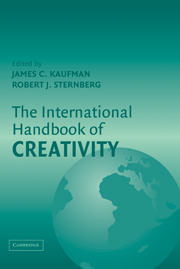Book contents
- Frontmatter
- Contents
- Acknowledgments
- List of Contributors
- 1 Introduction
- 2 Creativity Research in English-Speaking Countries
- 3 Creativity in Latin America
- 4 History of Creativity in Spain
- 5 Past, Present, and Future Perspectives on Creativity in France and French-Speaking Switzerland
- 6 Creativity in Italy
- 7 Creativity Research in German-Speaking Countries
- 8 Creativity Under the Northern Lights
- 9 Creativity in Soviet–Russian Psychology
- 10 Creativity Studies in Poland
- 11 Research on Creativity in Israel
- 12 Creativity in Turkey and Turkish-Speaking Countries
- 13 Development of Creativity Research in Chinese Societies
- 14 Creativity – A Sudden Rising Star in Korea
- 15 Culture and Facets of Creativity
- 16 African Perspectives on Creativity
- 17 Creativity Around the World in 80 Ways … but with One Destination
- Author Index
- Subject Index
- References
7 - Creativity Research in German-Speaking Countries
Published online by Cambridge University Press: 05 June 2012
- Frontmatter
- Contents
- Acknowledgments
- List of Contributors
- 1 Introduction
- 2 Creativity Research in English-Speaking Countries
- 3 Creativity in Latin America
- 4 History of Creativity in Spain
- 5 Past, Present, and Future Perspectives on Creativity in France and French-Speaking Switzerland
- 6 Creativity in Italy
- 7 Creativity Research in German-Speaking Countries
- 8 Creativity Under the Northern Lights
- 9 Creativity in Soviet–Russian Psychology
- 10 Creativity Studies in Poland
- 11 Research on Creativity in Israel
- 12 Creativity in Turkey and Turkish-Speaking Countries
- 13 Development of Creativity Research in Chinese Societies
- 14 Creativity – A Sudden Rising Star in Korea
- 15 Culture and Facets of Creativity
- 16 African Perspectives on Creativity
- 17 Creativity Around the World in 80 Ways … but with One Destination
- Author Index
- Subject Index
- References
Summary
Who or what is creative? Is it a person with especially brilliant ideas? An inventor, scientist, or artist? Is it a certain way of thinking? Is it imagination, inspiration, intuition, or systematic problem solving? Is it the environment, in which problems are worked on? Is it the perceived problem itself, the starting point, which enables creative problem solving? Or is it the result, as a product of problem-solving processes? All of these have been used in defining creativity.
Person, process, press, problem, and product are integrated in basic models of creativity (see Mooney, 1958; Preiser & Buchholz, 2004; Urban, 2003a) in the United States as well as in German-speaking countries. The models' focus lies on creative cognitive processes, which are initiated by a problem. These can be subdivided into different phases. In the end they should lead to a creative product. The creative processes are influenced by general and specific knowledge; by expertise, abilities, cognitive styles, and strategies; and by creativity-relevant personality traits, motives, interests, and task commitments (cf. the componential model of creativity by Urban, 2003a). Supporting or hindering environmental conditions and creativity techniques are also important. Only the result shows if an idea can be seen as successful and creative, explaining why the definitions of creativity revolve around the final result. The central criteria, which have been adopted from the United States, are novelty, suitability or usefulness, and social acceptance. What is accepted as useful or original depends on the historical situation as well as the social context.
- Type
- Chapter
- Information
- The International Handbook of Creativity , pp. 167 - 201Publisher: Cambridge University PressPrint publication year: 2006
References
- 6
- Cited by



